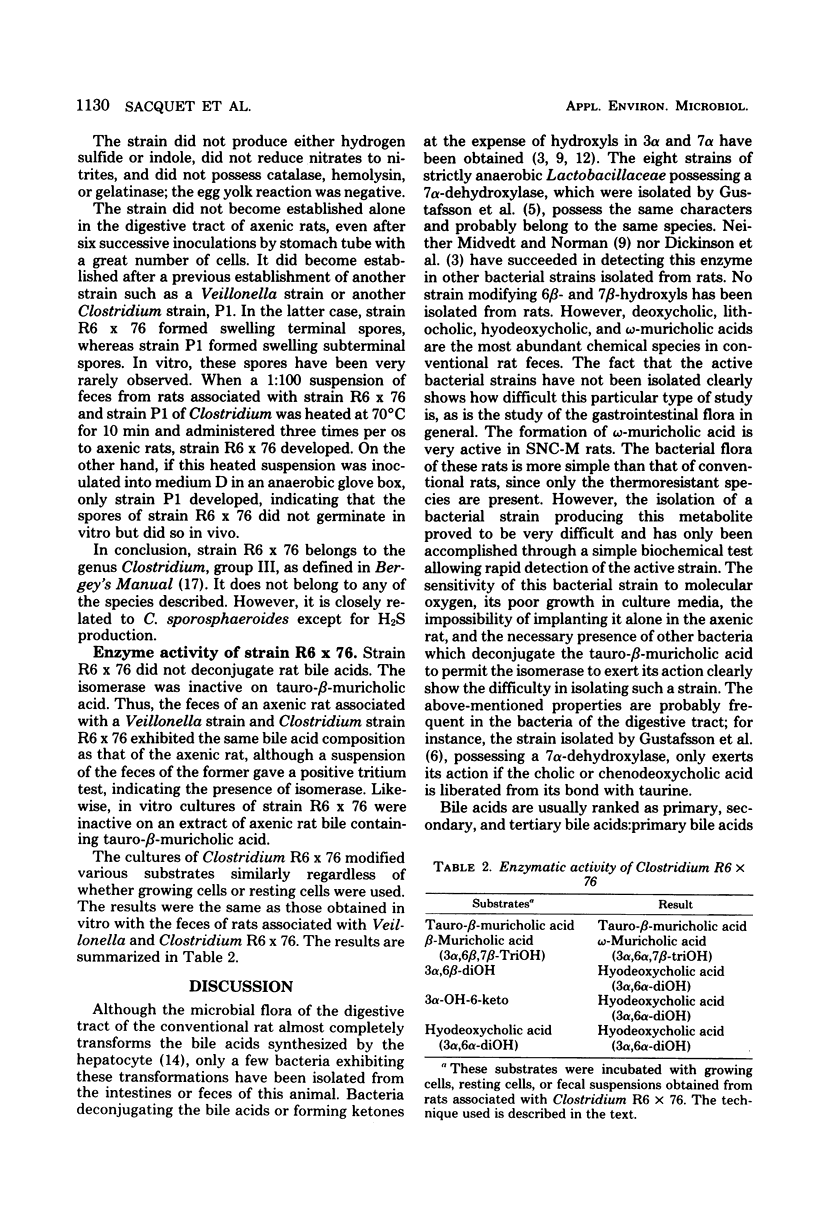Abstract
In the feces of conventional rats, the amount of omega-muricholic and hyodeoxycholic acids vary according to the diet. To understand this phenomenon, we investigated the bacterial formation of these bile acids. The present paper reports the first isolation, from conventional rat feces, of a strain of Clostridium group III which transforms beta-muricholic acid, the main bile acid in germfree rats, into omega-muricholic acid.
Full text
PDF




Selected References
These references are in PubMed. This may not be the complete list of references from this article.
- Arank A., Syed S. A., Kenney E. B., Freter R. Isolation of anaerobic bacteria from human gingiva and mouse cecum by means of a simplified glove box procedure. Appl Microbiol. 1969 Apr;17(4):568–576. doi: 10.1128/am.17.4.568-576.1969. [DOI] [PMC free article] [PubMed] [Google Scholar]
- Cohen B. I., Raicht R. F., Salen G., Mosbach E. H. An improved method for the isolation, quantitation, and identification of bile acids in rats feces. Anal Biochem. 1975 Apr;64(2):567–577. doi: 10.1016/0003-2697(75)90469-8. [DOI] [PubMed] [Google Scholar]
- Dickinson A. B., Gustafsson B. E., Norman A. Determination of bile acid conversion potencies of intestinal bacteria by screening in vitro and subsequent establishment in germfree rats. Acta Pathol Microbiol Scand B Microbiol Immunol. 1971;79(5):691–698. doi: 10.1111/j.1699-0463.1971.tb00098.x. [DOI] [PubMed] [Google Scholar]
- Einarsson K. On the formation of hyodeoxycholic acid in the rat. Bile acids and steroids 154. J Biol Chem. 1966 Feb 10;241(3):534–539. [PubMed] [Google Scholar]
- Gustafsson B. E., Midtvedt T., Norman A. Isolated fecal microorganisms capable of 7-alpha-dehydroxylating bile acids. J Exp Med. 1966 Feb 1;123(2):413–432. doi: 10.1084/jem.123.2.413. [DOI] [PMC free article] [PubMed] [Google Scholar]
- Gustafsson B. E., Midtvedt T., Norman A. Metabolism of cholic acid in germfree animals after the establishment in the intestinal tract of deconjugating and 7 alpha-dehydroxylating bacteria. Acta Pathol Microbiol Scand. 1968;72(3):433–443. doi: 10.1111/j.1699-0463.1968.tb00457.x. [DOI] [PubMed] [Google Scholar]
- Kellogg T. F., Wostmann B. S. Fecal neutral steroids and bile acids from germfree rats. J Lipid Res. 1969 Sep;10(5):495–503. [PubMed] [Google Scholar]
- Midtvedt T., Norman A. Bile acid transformations by microbial strains belonging to genera found in intestinal contents. Acta Pathol Microbiol Scand. 1967;71(4):629–638. doi: 10.1111/j.1699-0463.1967.tb05183.x. [DOI] [PubMed] [Google Scholar]
- Raibaud P., Dickinson A. B., Sacquet E., Charlier H., Mocquot G. La microflore du tube digestif du rat. I. Techniques d'étude et milieux de culture proposés. Ann Inst Pasteur (Paris) 1966 Apr;110(4):568–590. [PubMed] [Google Scholar]
- Rogosa M., Love L. L. Direct quantitative gas chromatographic separation of C2-C6 fatty acids, methanol, and ethyl alcohol in aqueous microbial fermentation media. Appl Microbiol. 1968 Feb;16(2):285–290. doi: 10.1128/am.16.2.285-290.1968. [DOI] [PMC free article] [PubMed] [Google Scholar]
- Sacquet E., Garnier H., Raibaud P., Eyssen H. Etiologie bactérienne de la stéatorrhée observée chez le rat porteur d'un cul de sac intestinal. Déconjugaison de l'acide taurocholique. C R Acad Sci Hebd Seances Acad Sci D. 1968 Dec 16;267(25):2238–2240. [PubMed] [Google Scholar]
- Sacquet E., Raibaud P., Garnier J. Etude comparée de la microflore de l'estomac, de l'intestin grêle et du caecum du rat "holoxénique" (conventionnel), et de ses modifications à la suite de diverses interventions chirurgicales: anse aveugle jéjunale, déviations biliaires. Ann Inst Pasteur (Paris) 1971 Apr;120(4):501–524. [PubMed] [Google Scholar]
- Sacquet E., Van Heijenoort Y., Riottot M., Leprince C. Action de la flore microbienne du tractus digestif sur le metabolisme des acides biliaires chez le rat. Biochim Biophys Acta. 1975 Jan 24;380(1):52–65. [PubMed] [Google Scholar]
- Siegfried C. M., Doisy E. A., Jr, Elliott W. H. Bile acids. XLIV, quantitation of bile acids from the bile fistula rat given (4-14C) cholesterol. Biochim Biophys Acta. 1975 Jan 24;380(1):66–75. doi: 10.1016/0005-2760(75)90045-4. [DOI] [PubMed] [Google Scholar]
- Wostmann B. S., Beaver M., Chang L., Madsen D. Effect of autoclaving of a lactose-containing diet on cholesterol and bile acid metabolism of conventional and germ-free rats. Am J Clin Nutr. 1977 Dec;30(12):1999–2005. doi: 10.1093/ajcn/30.12.1999. [DOI] [PubMed] [Google Scholar]
- Wostmann B., Bruckner-Kardoss E., Chang L., Beaver M., Madsen D. Effect of dietary lactose at levels comparable to human consumption on cholesterol and bile acid metabolism of conventional and germfree rats. J Nutr. 1976 Dec;106(12):1782–1790. doi: 10.1093/jn/106.12.1782. [DOI] [PubMed] [Google Scholar]


